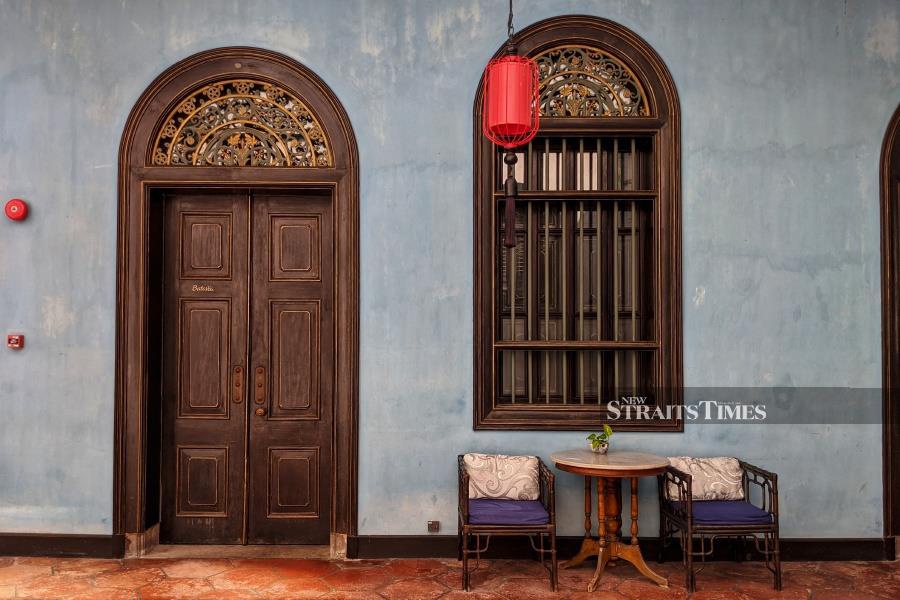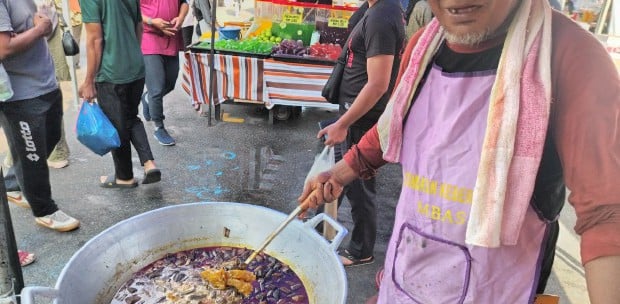SALLY, our tour guide, stands ready in the grand entrance hall and welcomes us to the Blue Mansion. Without missing a beat, she proceeds to give a clear and detailed briefing encompassing the history, architecture and conservation work done to bring back the mansion back to its glory days.
Her presentation is interesting and polished, perhaps honed by years of experience bringing visitors on tours around the Blue Mansion.
While trying to listen to and absorb everything Sally says, my eyes can't help but to wander and take in the sights of the lobby like tall vases, ebony chairs inlaid with mother-of-pearl and even small bats carved near the top of the structural posts holding up the hall.
Sensing our excitement, Sally teases at the screen behind her. It is a floor-to-ceiling carved and gilded screen, exuding a quiet but majestic charm.

Walking past the screen I discover what is perhaps one of the most beautiful inner courtyards I have ever seen.
Outwardly looking like a traditional Chinese courtyard, it is only on closer inspection and when highlighted by Sally that I could see European architectural cues and building material.
Looking up while standing in the middle of the courtyard, I see intricate wrought iron grills encompassing the upper level which was brought all the way from Scotland.
Four grand pillars border each corner of the courtyard, casted in iron and in an ornamented Corinthian style.
Feng Shui is a practice of arranging certain pieces in living spaces in order to create balance with the natural world.
Also known as Chinese Geomancy, the purpose of Feng Shui is to harness energy forces while maintaining a harmonious balance between an individual and their environment.
Still standing at the centre of the courtyard, Sally asks us if we feel any bit different than before. Answering yes, she tells me that is the Feng Shui of the Blue Mansion.
Apparently, Feng Shui masters were consulted during the construction of the mansion and the courtyard is believed to have the highest concentration of these energy forces.

NOT JUST A MUSEUM
Built during the 19th century, the Blue Mansion or Cheong Fatt Tze mansion featured 38 rooms, five courtyards, seven staircases and 220 windows.
However, through the passing of time, the fall of personal fortunes and neglect, the mansion gradually became severely dilapidated.
It was only sometime in 1990 that the mansion came into the hands of a group of people intent on returning it to its beautiful and original state.
Six years of conservation work repairing and restoring as much as possible the original structure of the Blue Mansion culminated in the restoration project winning the Most Excellent Project award at the Unesco Heritage Awards in 2000.
And today, the mansion boasts 18 beautifully conserved and restored suites, each decorated with family heirlooms.
What's interesting about the Blue Mansion in this regard is that it is not merely a museum or a historic architectural showcase, but also a boutique hotel providing guests a chance to live in opulent luxury of a 19th century Chinese tycoon.
The 18 restored suites are available as accommodations for guests, located on both wings of the mansion with its own smaller courtyards. And although the suites have been faithfully restored, modern amenities have also been included to ensure a more comfortable stay.

Sitting on a chair near the door of my suite, I can't help but wonder what life must have been like living in the mansion back in its glory days.
Looking at the intricate iron work of a gently spiraling staircase and tinted glass windows near the suite's courtyard, I notice again the blue tint of the walls that gave the mansion its name.
Apparently, the colour blue was very popular during the Colonial period of the 19th century.
Made from lime mixed with natural blue dye made from the Indigo plant, the blue lime paint was quite effective in tropical climates to absorb moisture and cool the interiors of buildings back during the colonial days.
It makes sense then that the Blue Mansion has also been featured in various period films, serving as a background to films such as the Red Kebaya and Road to Dawn.
AN ARCHITECTURAL GEM
Commissioned in the 1890s by Cheong Fatt Tze – an illustrious, self-made tycoon nicknamed the 'Rockefeller of the East' – the iconic Blue Mansion is an important architectural heritage that highlights the work of 19th century artisans, materials and construction methods.
And after being so faithfully restored and also serving as a boutique hotel, visitors who spend the night can better appreciate its beauty while reliving Penang's colonial past.
FAST FACTS

Cheong Fatt Tze's Blue Mansion
14, Leith Street
10200 Penang
TEL 04-262 0006
FAX 04- 262 5289
EMAIL cheongfatttzemansion.com
STAY There are only 18 rooms, each is furnished and adorned in a style or theme that centres on the mansion's history. With its own smaller courtyards featuring a pond and garden, guests are able to have more privacy when daily tour groups visit.
EAT Three outlets: The Indigo restaurant for some casual dining, The Bar for drinks and refreshments and the Courtyard where breakfast is served.
DO The inhouse gallery of the Blue Mansion features informative displays and exhibits of the mansion's past and conservation work done. Daily tours are also available, covering guided visits to the reception hall, central courtyard and the museum gallery. A gift shop is also available.
GO Located in the heart of Georgetown, Penang's capital on the north-eastern side of the island and Unesco World Heritage Site, there is plenty of spots to visit during a stay at the Blue Mansion.
HIGHS Opulent and luxurious, the stay at the Blue Mansion will definitey make you wish you were born into a Penang tycoon family back during the 19th century instead of now.
LOWS The traffic to get to the Blue Mansion can be a bit hectic since it is in the heart of George Town. Taking e-hailing ride, taxi or simply walking on foot can be a better chocie.
Discover the beauty of Penang and book affordable flights with MAS Airline Promo.



